How Long Before Sunset Does The Sky Change Color
Predicting Sunrise and Sunset Colors
The holy grail for mural photographers is to be able to accurately predict sunrise and sunset colors. I'm sure we've all had the experience of thinking that the sunset was going to be bully only to have the colors fizzle out. Or maybe you thought there wasn't much potential and started driving home merely to be stuck on the interstate when the colors exploded.
In this article, I will discuss how I predict the colors for sunrise & sunset as well as link to the various tools that I use to inform my predictions.
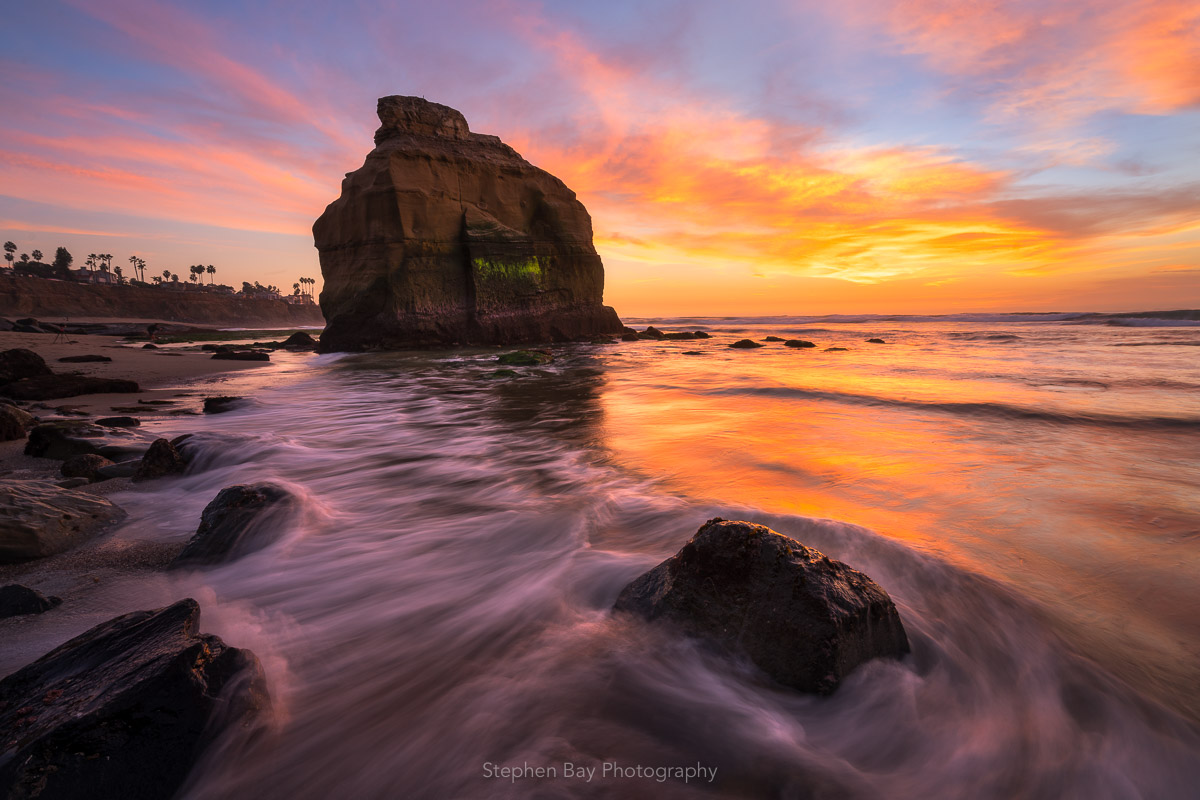
Requirements for Sky Color
First, lets talk about what we need to get those colorful skies. In some ways, it's simple and we demand merely ii things:
- High clouds to grab the sunday's rays as it rises/sets.
- A clear horizon and so that the sunlight is non blocked.
The platonic state of affairs is that the sun is at or below the horizon and the light rays have a directly and unobstructed line of sight to the underside of the clouds in your composition. Equally the light travels through the atmosphere, the blueish light rays scatter more than when the sun is direct overhead. This leaves but the gorgeous warm yellows, oranges, pinks and reds to illuminate the underside of the clouds.
However prediction gets complicated for multiple reasons. First, we have to predict many hours in advance. For sunrise, I need to determine the nighttime before whether I'thou going to get upwards early on and for sunset I demand at least an hr of atomic number 82 time for local shoots. 2nd, "clear" and "loftier" are not binary attributes. At that place are manifestly varying degrees of both characteristics and they interact to either permit the colors shine through or to cake the lord's day.
For case, in this next pic, although there is a marine layer (low clouds on the horizon), it was not dumbo plenty nor loftier enough to forbid a spectacular sunset.
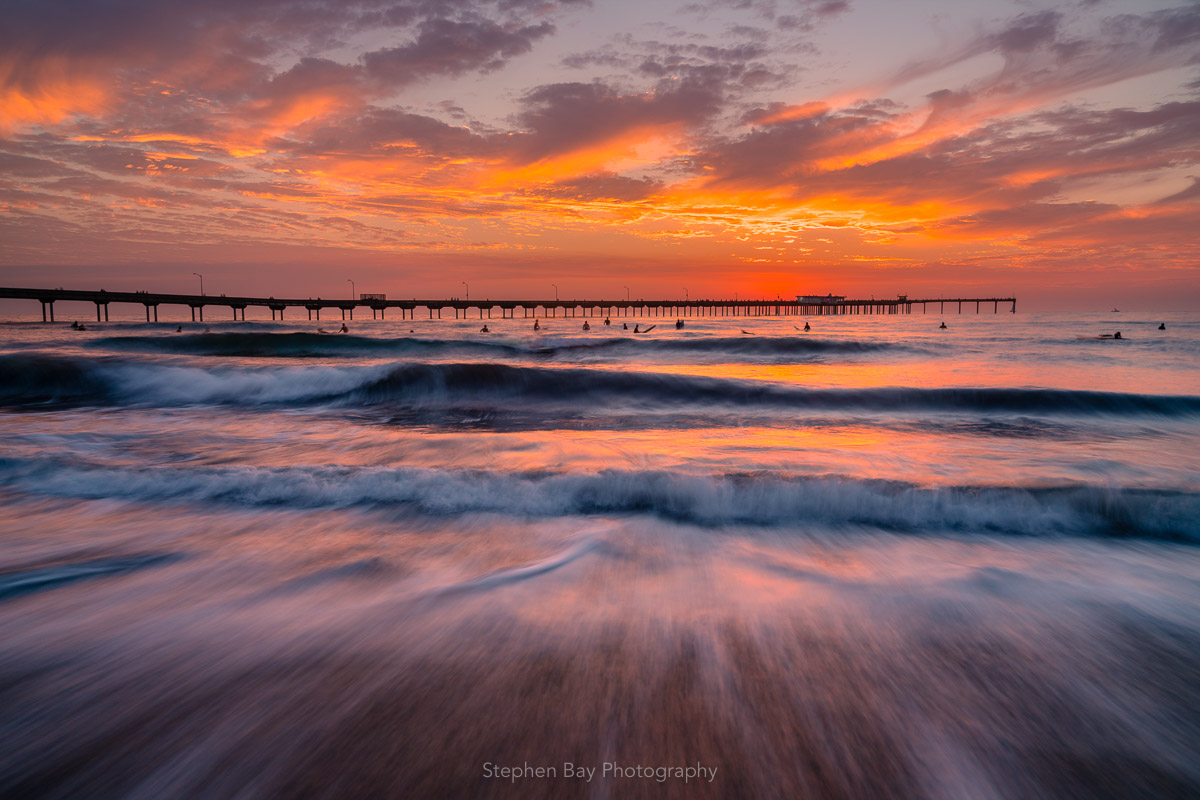
Sometimes the 24-hour interval tin can be completely overcast and grayness, merely if at that place is fifty-fifty a modest opening in the clouds, the sky can explode at sunset. In the adjacent scene, the opening was the small bright wedge that you tin see by the terminate of the pier. Every bit sunday dipped beneath the horizon, information technology was able to ignite the sky through the wedge. This was one of the near overpowering sunsets I've experienced and I actually found it to be too colorful for my gustatory modality.
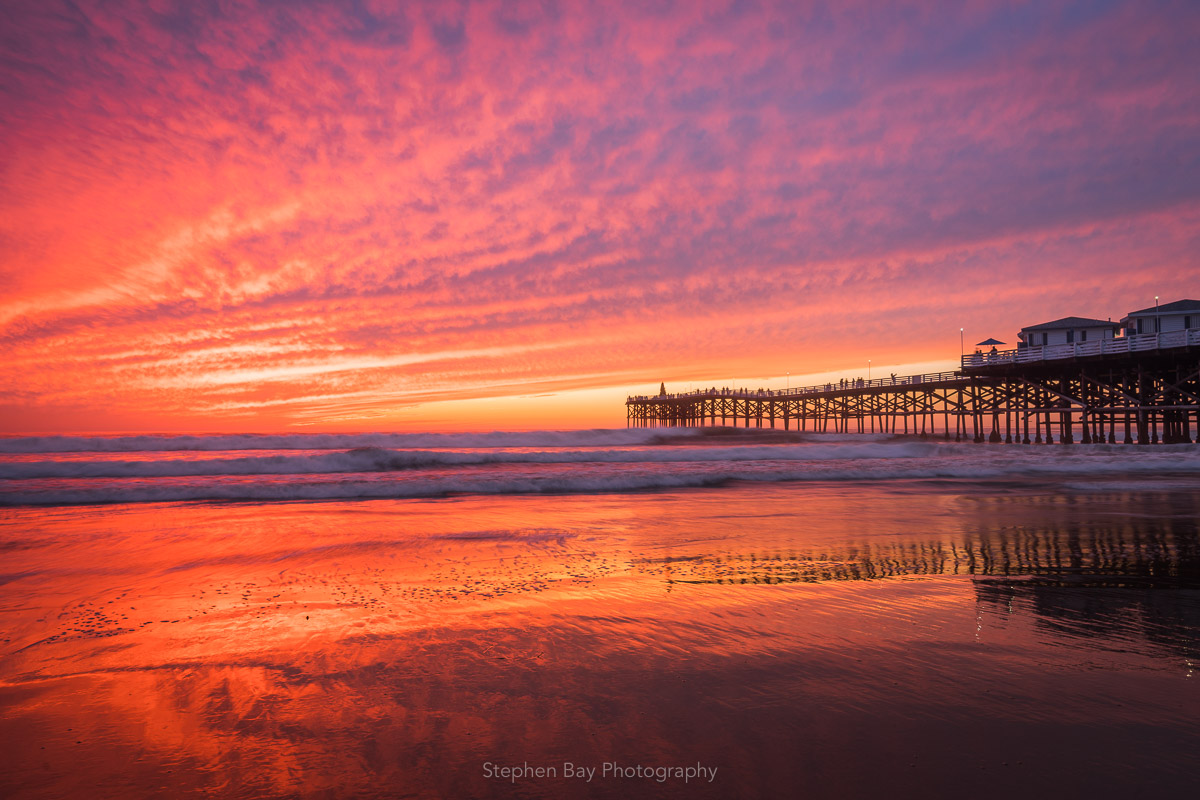
In this 3rd example, nosotros have multiple cloud formations. On the horizon, there is an extremely thick depression-lying cloud layer that blocks the sun. But we also have high wispy clouds that can still caught the sunlight colors. In the center of the frame, there are a few low clouds blowing in from offshore that were not high enough to catch any directly calorie-free.
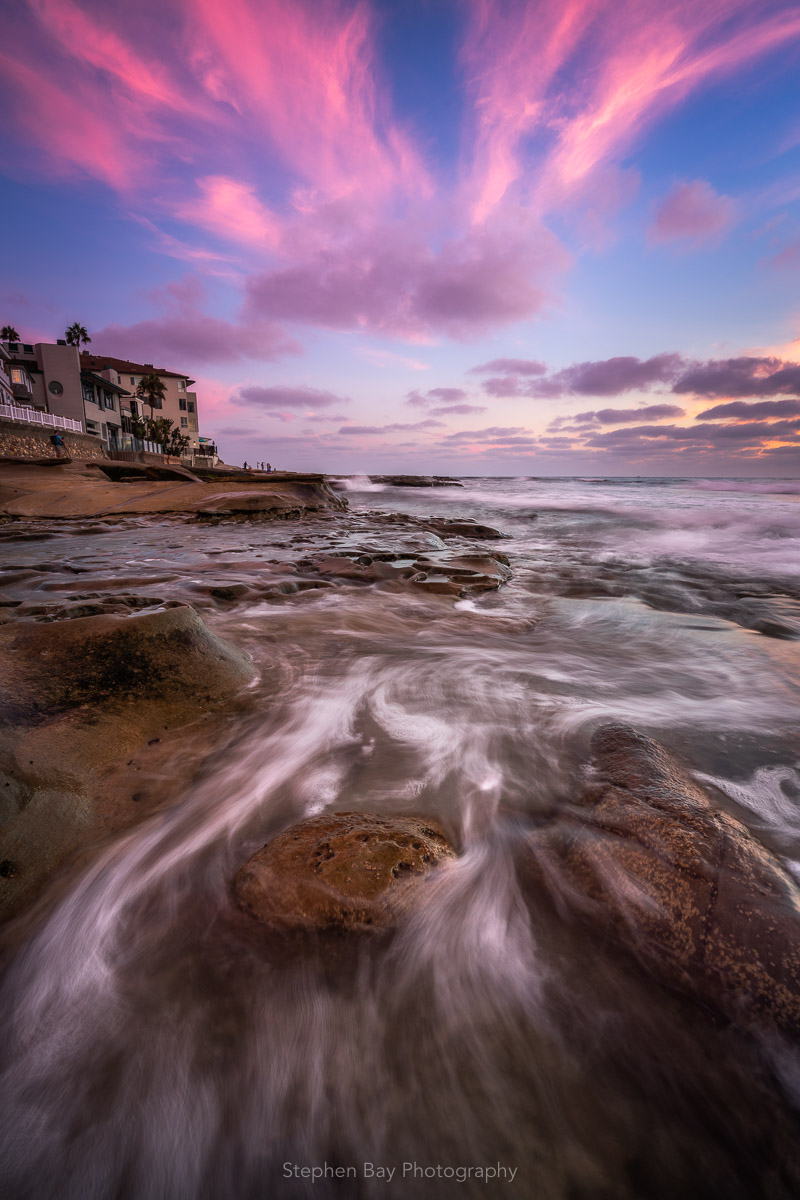
In this last case, we take a cloud formation that is nigh straight overhead of the shooting position. Almost of the deject was not illuminated but the trailing edge was just high enough to grab the light equally the sun dipped below the marine layer and horizon. There is another cloud in the altitude that was as well low for sunset colour.
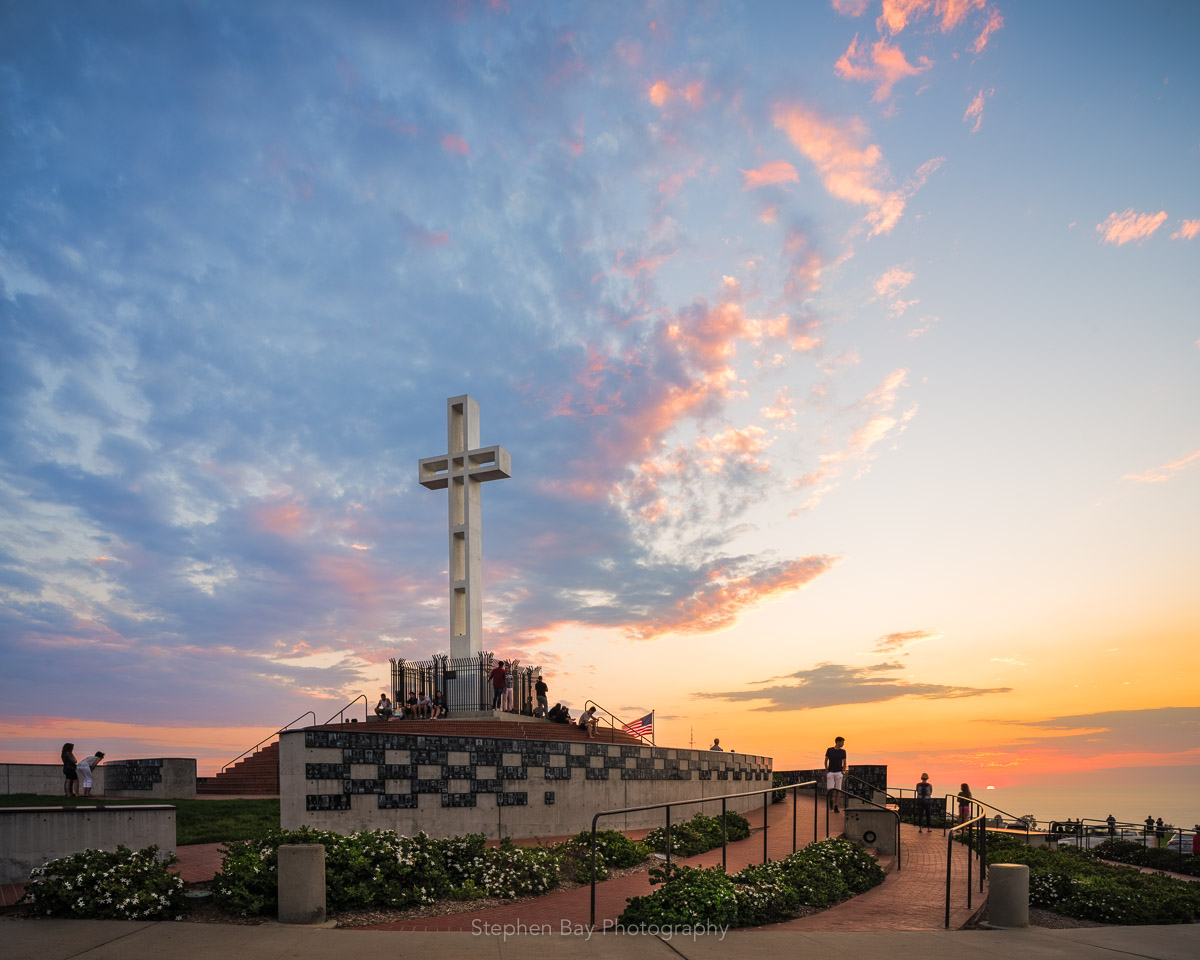
You will have to use your judgement about the deject height and clearness of the horizon. This will be hard at outset, but as you proceeds experience, it will become easier and y'all will brand more accurate predictions.
Short Time Frame Predictions (0-4 hours beforehand)
I employ different methods for predicting whether the sunrise/sunset is going to be good depending on the lead time. For brusque fourth dimension-frame predictions, I try to get a direct read of the cloud comprehend based on current conditions. I and then consider air current speed and management before making a conclusion.
Naked Eye View of the Horizon
My preference is to get a direct await at the horizon with my ain optics. For sunrise you can ofttimes run across the colour starting to emerge well before the colors top, perhaps equally much as hour before the official sunrise time. The peak colour usually occurs perhaps fifteen-20 minutes before sunrise so that leaves yous some time to become to your shooting location or decide if yous desire to become back to sleep.
For dusk I volition await at the horizon and judge the size and density of any clouds that might block the low-cal. I volition also look for any breaks in the cloud cover where the sun could shine through. Some of the nearly colorful sunsets I've experienced were when the sky was almost completely clouded but in that location was a small opening of clear sky for the sun to come through.
Although my office window faces west, I tin't actually see the horizon due to buildings blocking the view then I will sometimes go to the superlative of a nearby parking garage (10 stories high).
Another pick is to ping a photography friend who is in a improve location. Since I'one thousand often shooting seascapes, I'll message friends who work near the declension to get their read on the sky.
Existent-Time Satellite View of Cloud Cover
In addition to a naked eye view, I volition check existent-time satellite images of deject cover. I use the GOES satellites (Geostationary Operational Environmental Satellites) operated by NOAA. To see the satellite images first go to
https://www.star.nesdis.noaa.gov/GOES/
And so select your region. This will have y'all to a new page with a number of imagery options based on the light wavelength. I commonly select the first selection: Truthful Color daytime, multispectral IR at night.
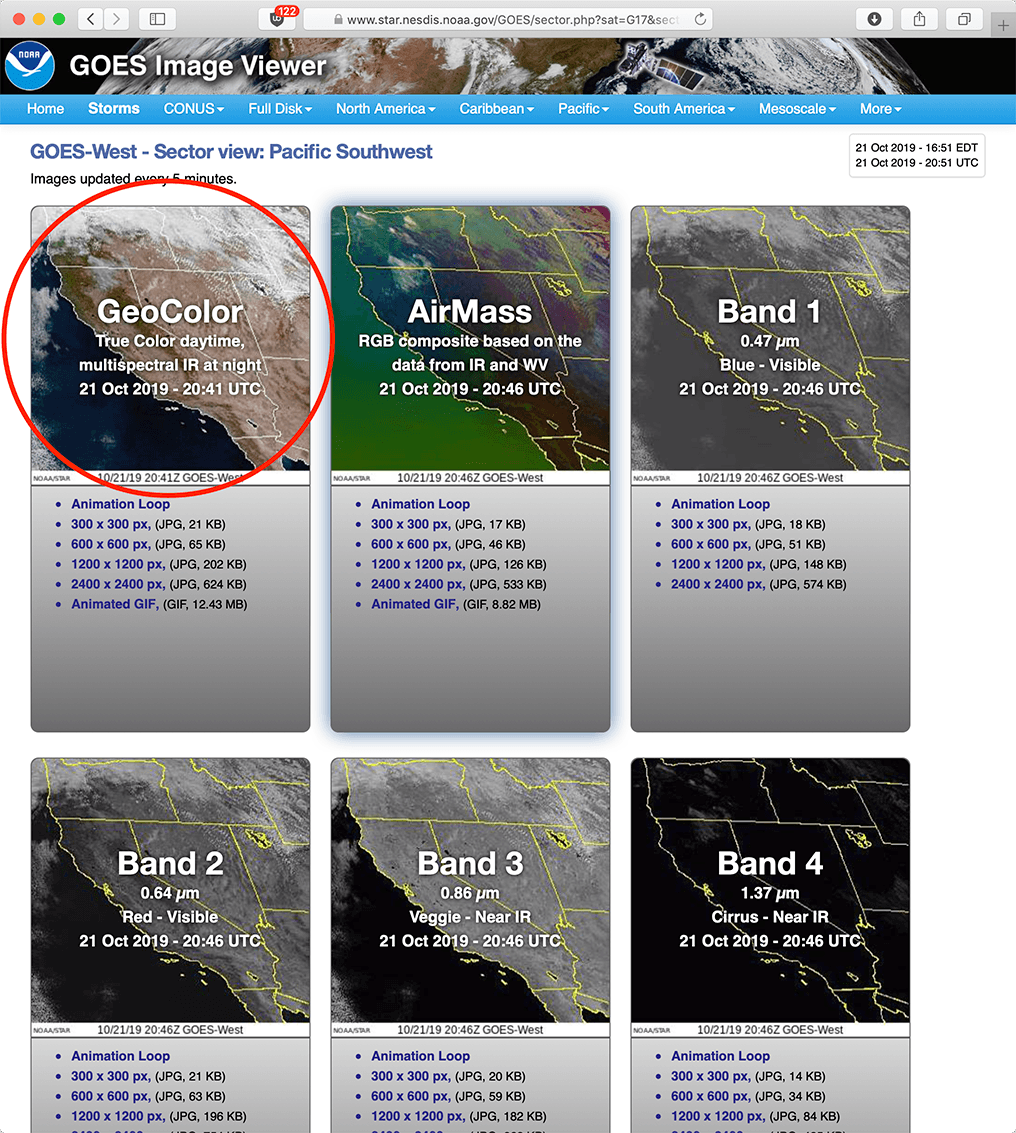
This reveals a existent-time epitome of the electric current cloud cover weather condition. Looking at my area, San Diego, shows that there aren't whatever clouds for hundreds of miles. Not a good candidate for sky colour although information technology's slap-up atmospheric condition for shooting the night heaven.
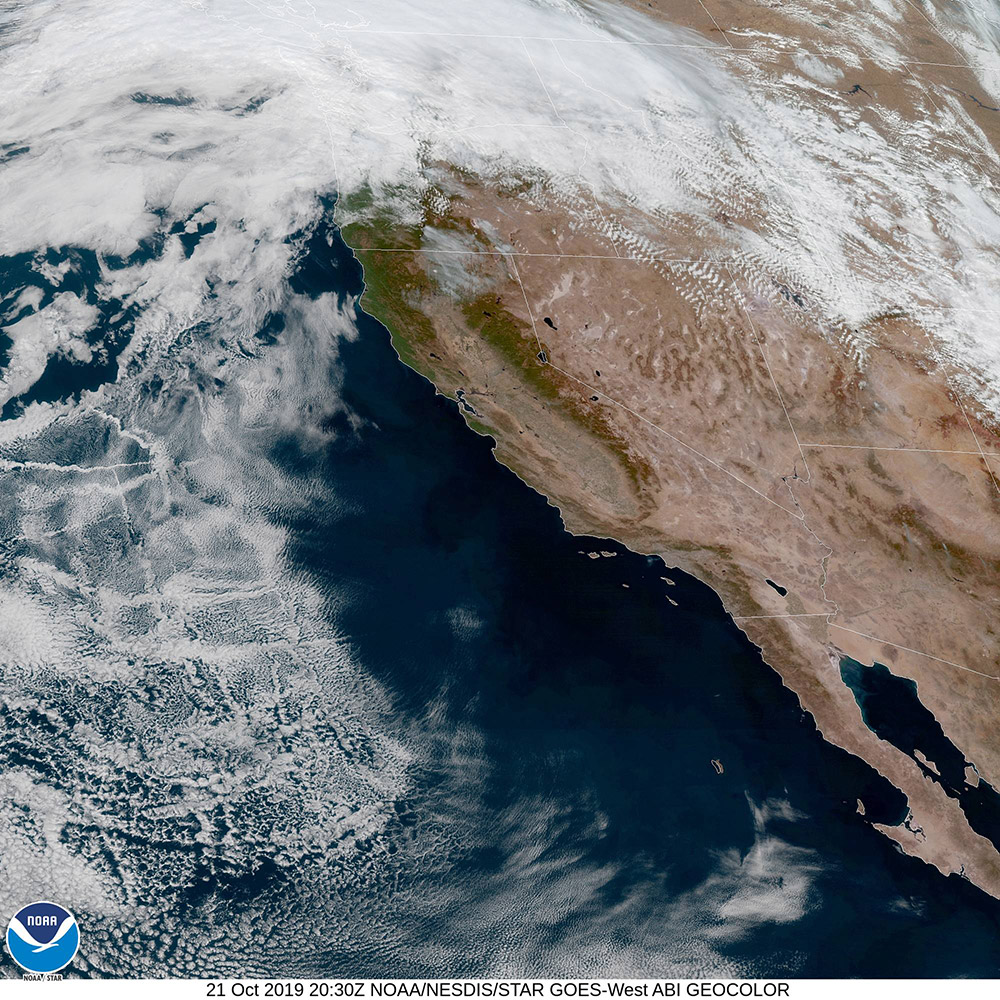
Below is a dark image using infrared imaging. On the paradigm, the blueish colors are liquid water clouds (east.1000. fog or stratus) while white or gray represents higher ice clouds. Note that the city lights exercise not come from the satellite and are instead added from split up static source.
This was a few minutes earlier sunrise and you can see a layer of clouds on the s side of San Diego. I couldn't shoot the sunrise this forenoon but thought there was a skillful gamble of getting decent color in the sky as the forecast from the dark before was for high clouds (see section below on long range forecasts).

The website also provides an animation of the last hour'due south worth of satellite images. This will show the direction and speed of cloud movement which can assist your prediction. I typically look at this if the cloud pattern is thin and there'southward more than 60 minutes earlier sunrise or dusk.
Webcams
If I tin't get a direct visual of the horizon, I will look at webcams that are pointed in the correct management. I alive in San Diego and there are many webcams here because plainly surfers also check these too. Here are a few I like to look at
- Hotel Del
- Ocean Embankment Pier
- Scripps Pier webcam
- La Jolla
It can be tricky judging cloud density on the webcam feed and yous will probably demand some feel comparing the webcam's view to the bodily situation when you go out to photograph. Webcams also utilize automatic exposure and white residue which can dramatically change the color and brightness of the prototype.
Y'all may likewise take to practice some searching on Google to find a adept fix of webcams for your expanse. Keep in listen that these often go in and out of service. In addition, double check the time-stamp equally sometimes they may broadcast an older feed.
Long Time frame Predictions (4+ hours beforehand)
For longer range forecasts, I apply a few different approaches and tools to predicting sky colors.
Weather Models (ECMWF, GFS, NAM, etc)
There are multiple conditions models that can forecast the location, density, and superlative of cloud embrace. I utilise these when I need to predict more four hours alee of time. The most pop models that yous may run into are:
- ECWMF (European Eye for Medium-Range Weather Forecasts)
- GFS (Global Forecast Organisation)
- NAM (Northward American Mesoscale Model)
These models accept different algorithms, spatial resolutions, and update frequencies. In my feel the ECWMF model (European) has been the most accurate for me in San Diego which is somewhat surprising because GFS and NAM are made by United states organizations. But you should test this for your specific area.
I find the near convenient place to view the forecast is on windy.com (as well available as a phone app). Yous can see both the cloud cover per centum and altitude of the deject base.
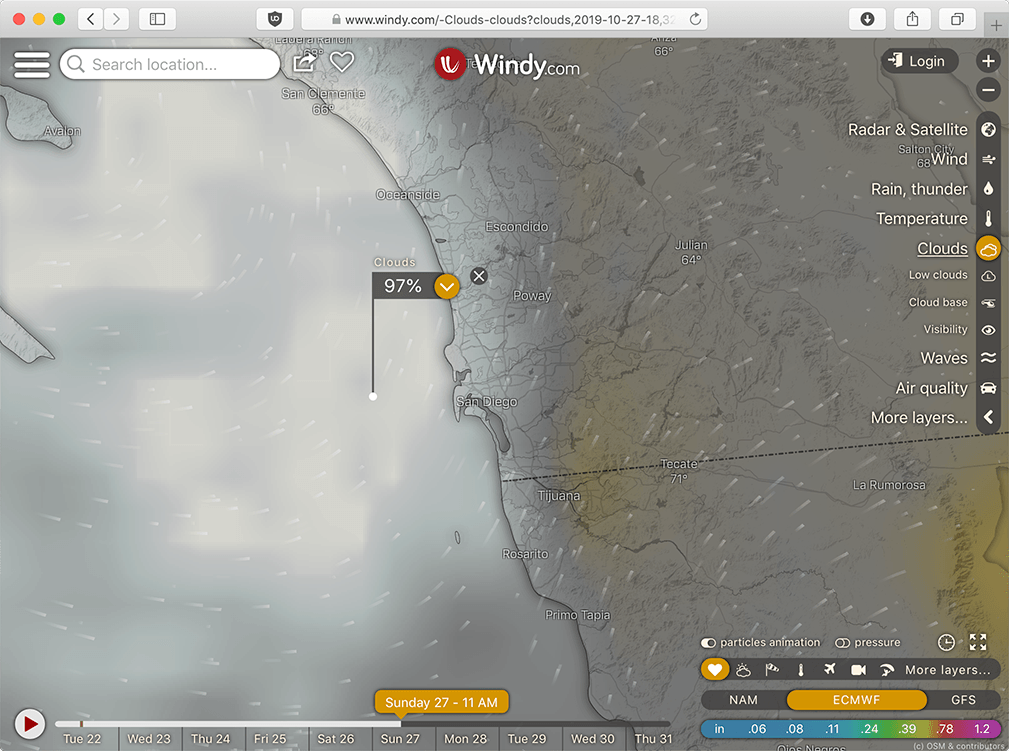

Windy can also display GFS information but I prefer to view that model's forecast here:
https://tropicaltidbits.com/assay/models/
First select a region then choose either "Lower Dynamics" or "Upper Dynamics" and pick cloud fraction.
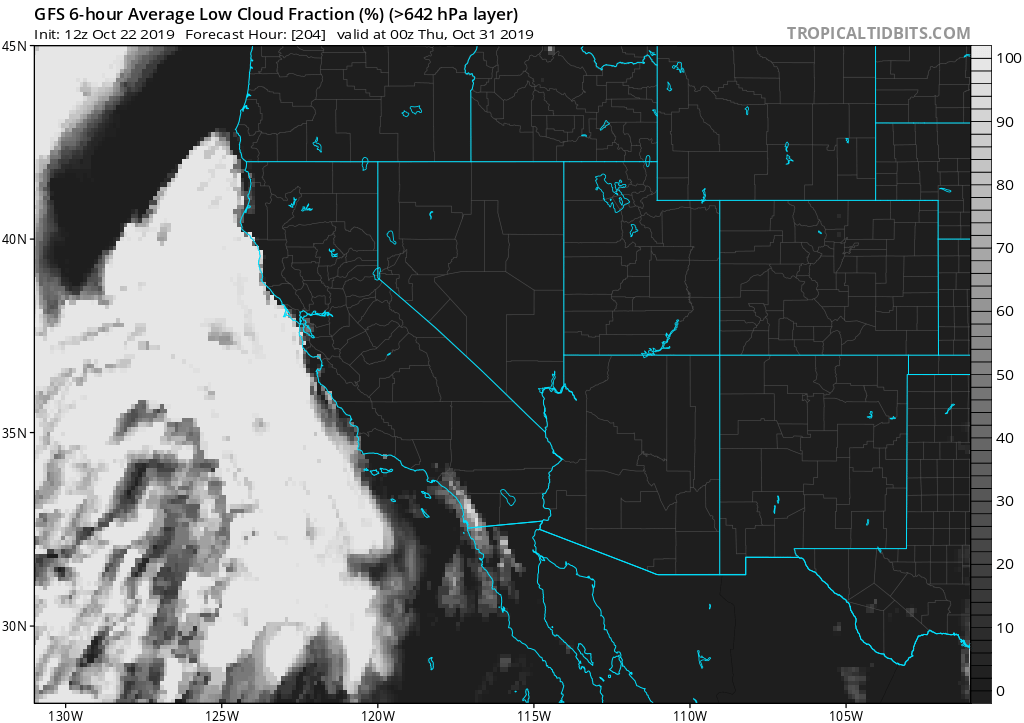
Depending on what site y'all visit, you may come across the forecast time listed in your local time zone or as "zulu" fourth dimension. Zulu time refers to Universal Coordinated Time (UTC) which was formerly called Greenwich Mean Time. In San Diego, nosotros are at UTC-7 during daylight saving time and UTC-8 during standard time.
Rule of Thumb
Sometimes I use a simple rule to predict sunrise/sunset color:
IF at that place has been a expert sunrise (sunset) in the past few days AND in that location is a forecast for fractional cloud cover Then there is a good chance of colour at sunrise (sunset) This can be helpful during the fall/wintertime months in my area as we will oftentimes get a few good sunrises/sunsets in a row.
Prediction Websites and Apps
Finally, there are websites and apps that have in all of the forecast information and effort to automatically predict sunrise/sunset colour. The two most popular ones are SunsetWx and Skyfire (IOS app only).
In my experience, SunsetWx is not very good. It'southward based on the GFS & NAM forecast models which are non as accurate equally ECWMF in my area. Merely if SunsetWx predicts a very colorful sunrise/sunset I volition frequently check my other sources. I don't use Skyfire every bit it requires a paid subscription but friends who have used information technology say that it is but so-so at making preditions.
Here is an example prediction map from SunsetWx. A more colorful sunset is denoted by warmer colors (i.eastward. xanthous, orange, and red).
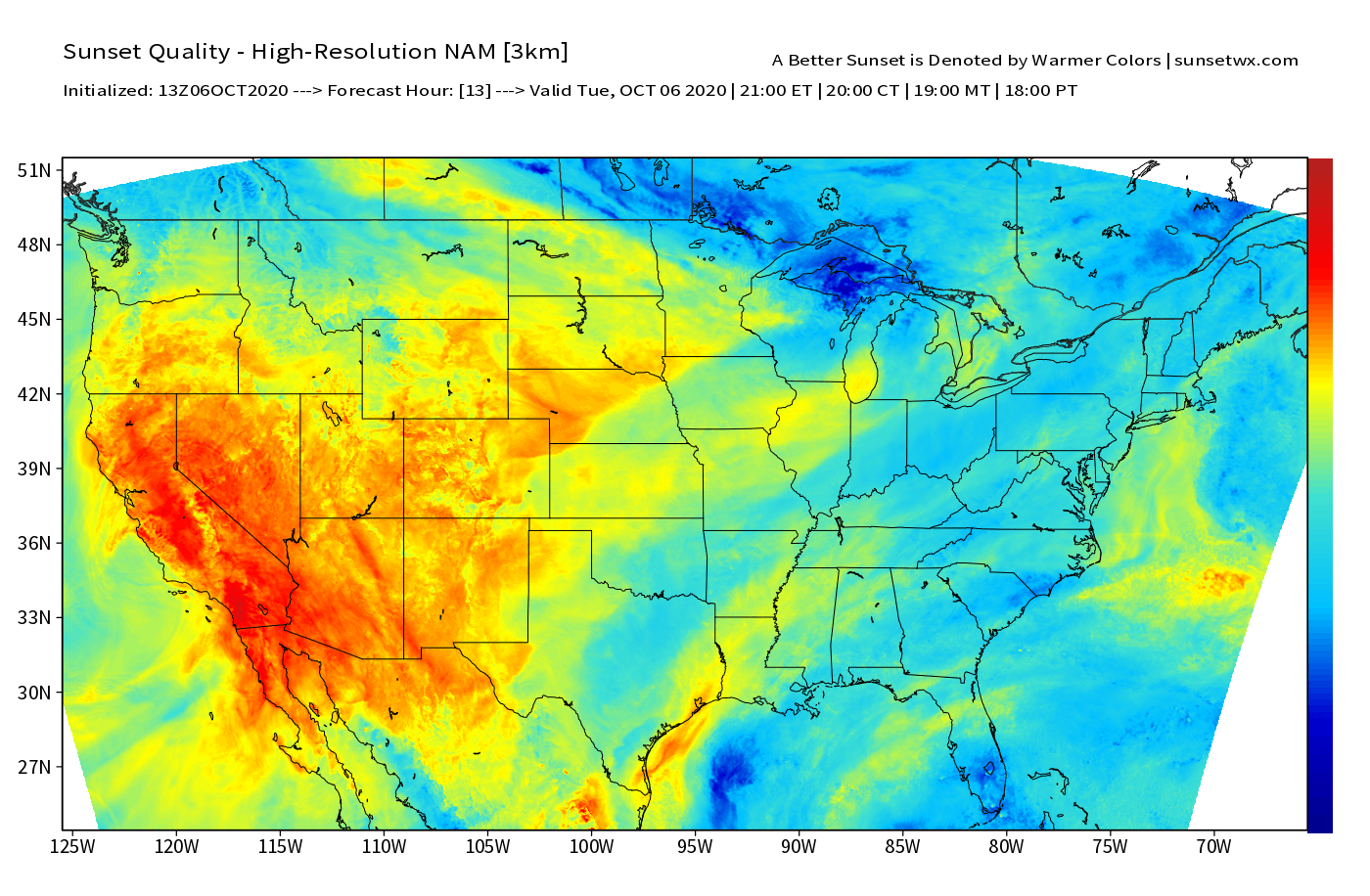
Recently I discovered some other website Crispy Heaven that is based on the NAM forecast model. I'thou still evaluating the service but compared with SunsetWx, it tends to exist more conservative and highlights smaller areas as having a colorful sky. Also note the divergence in the south-east states.
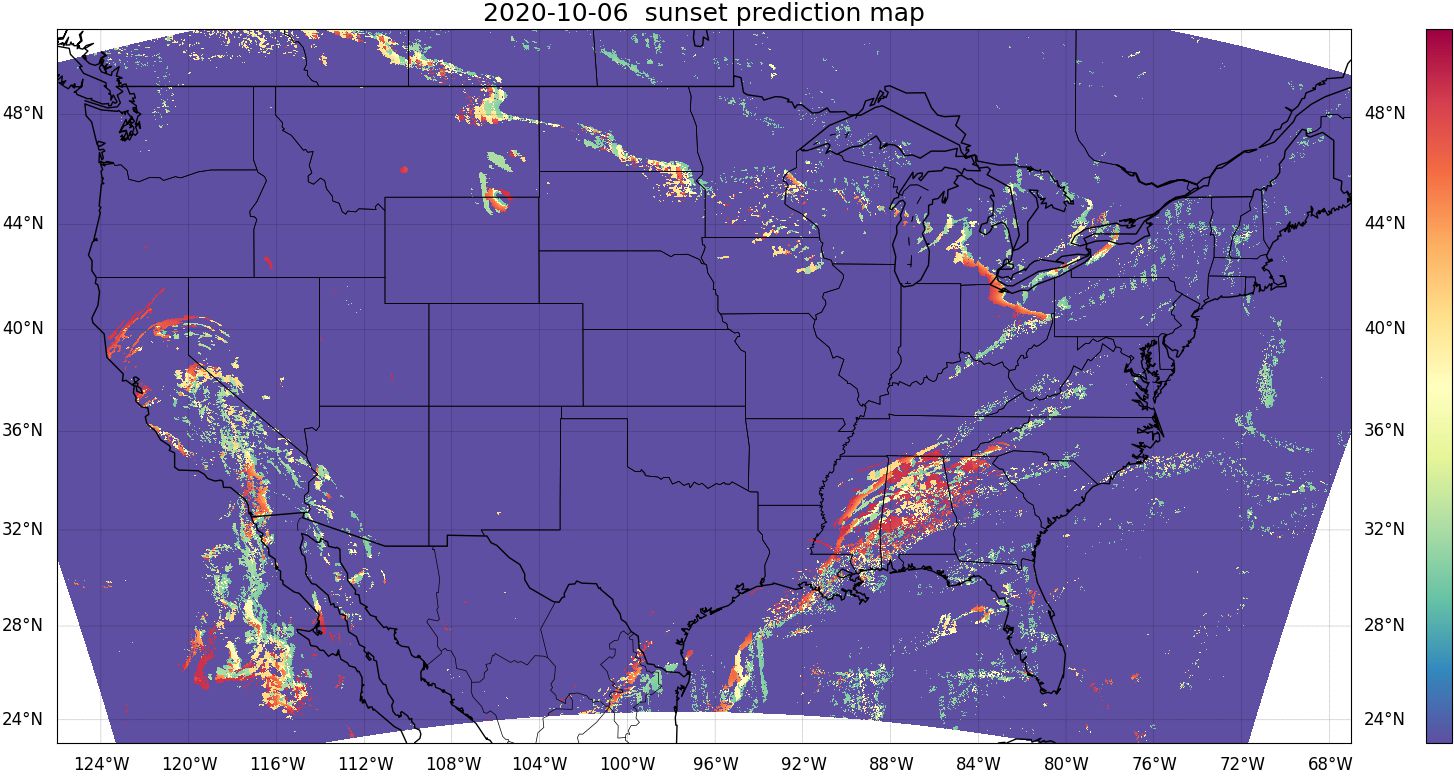
Example Predictions
In this section, I'll include some examples of predictions I've made. This is a work in progress and I'll add more over time.
Dusk i/2/20 in San Diego
About two.5 hours before sunset, I was deciding on whether to go to the coast in La Jolla and shoot the dusk. Here are screenshots of the information I looked at earlier deciding:
- satellite paradigm of clouds
- blitheness of cloud movement
- SunsetWx prediction
- webcam facing due west to the declension
The satellite images and animation suggest practiced conditions for sunset (partly cloudy with breaks for the sun to lite the heaven). SunsetWx is negative and advise poor weather condition. The webcam indicates that the clouds are thicker than I would expect from the satellite images only because information technology's winter, I know that the sunday can often shine through the clouds to provide color.
Ultimately I decided to go and here are a few shots from my camera with a flat profile and minimal processing:
- xxx minutes earlier sunset
- 14 minutes after sunset
Sunset i/7/20 in San Diego
In the early on afternoon, about 3 hours before sunset, a friend pinged me and asked I wanted to become photograph. Here are the screenshots of information:
- SunsetWx prediction
- satellite image of clouds
- animation of cloud movement
- webcam facing west to the declension
SunsetWx made a prediction for a very potent sunset but the data from the satellite images and webcam suggested that the clouds would merely be in the northern sky equally viewed from San Diego. Cloud movement suggested that the pattern would continue (good clouds in the n) into dusk.
Based on the to a higher place information, we went out to photograph. First starting in La Jolla and looking for good northern views and and then nosotros made our way up to Carlsbad. Here is the event:
- 9 minutes after sunset
The sunset was very proficient but but in express directions that required specific compositions.
Sunset 1/eight/20 in San Diego
About an 60 minutes before sunset, I was deciding whether it would be worth going out to photograph:
- satellite image of clouds
- webcam facing west to the coast
- deject cover predition
I thought both the satellite images and webcam looked promising. However, the forecast was for a pregnant corporeality of depression lying clouds at dusk. I decided to go to shut location and here is the effect:
- 4 minutes before sunset (cell phone film)
The low clouds blocked most of the sunlight and although there some gaps where the colors could come up through.
Larn seasonal & local patterns for your area
I think it'south of import to learn seasonal and local atmospheric condition patterns. For example, in San Diego
- We get heavy marine layer that blocks the sun in spring and summertime months. During this fourth dimension nosotros might have 1 skillful sunset a calendar month. So the prior probability is very depression and unless in that location are other strong signals I presume there volition be lackluster colors.
- Sunset season starts around beginning of November and goes until March/April. We might average about one good sunrise/dusk a week. But there will be some weeks where we get as many as iii or 4 great days in a row.
- Due to topography, various spots tend to develop certain cloud patterns which you can leverage. For example, Balboa Park is located on the height of a hill and frequently gets clouds that class as the current of air comes in from offshore. These can frequently light up (although you have to exist in the right spot to take reward of information technology).
- Santa Ana winds which accident hot dry out air from inland areas out to the coast often occur in the autumn (although they tin be year circular). Normally this ways very clear air and no clouds which is bad for sunrise/sunset colour merely great for night heaven photography.
- The declension ofttimes develops heavy fog or cloud cover that rolls in correct around sunset. This blocks the sky color considering yous are literally standing in the deject, simply the sunset can still be dandy if you motility a few miles inland.
Final Thoughts
I was initially very bad at predicting sunrise and sunset color but this is a skill that tin be learned. I started by watching the cloud formations and weather information and making a prediction of how I thought the sky would plough out regardless if I could actually go out and shoot that mean solar day. I then made note of how the sunrise/sunset turned out – this helped calibrate how I interpreted the various information sources.
Eventually with enough feedback, you'll go better at predicting sky colors. However, prediction is inherently hard and in that location's a limit every bit to how accurate yous can be. I don't look to ever be more than the 30-50% accurate at predicting a colorful sunset and significantly less than that for sunrise. Nevertheless, my motto is when in doubt, get out and shoot. In the worst example, yous get to spend a pleasant hour or two in the outdoors.
Source: https://stephenbayphotography.com/blog/predicting-sunrise-and-sunset-colors/
Posted by: thomastheactiones.blogspot.com

0 Response to "How Long Before Sunset Does The Sky Change Color"
Post a Comment